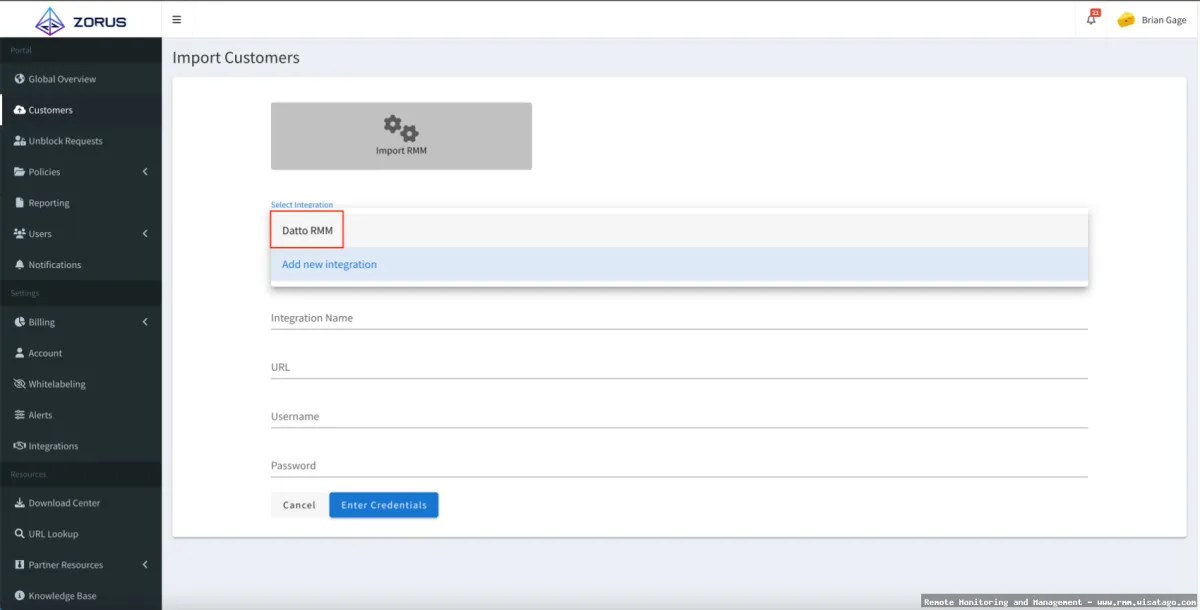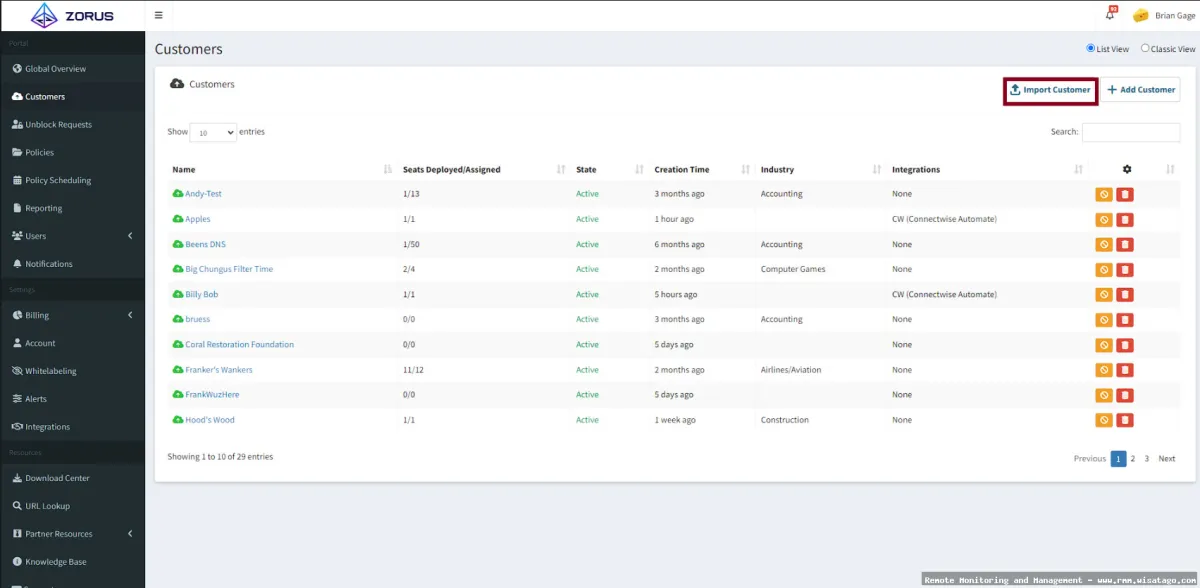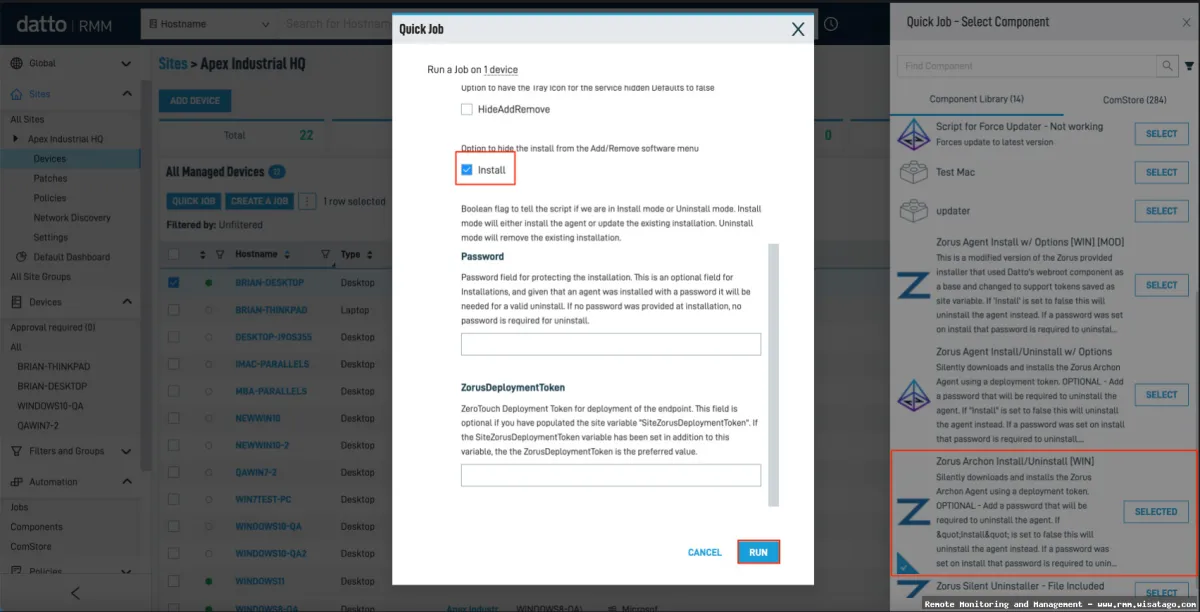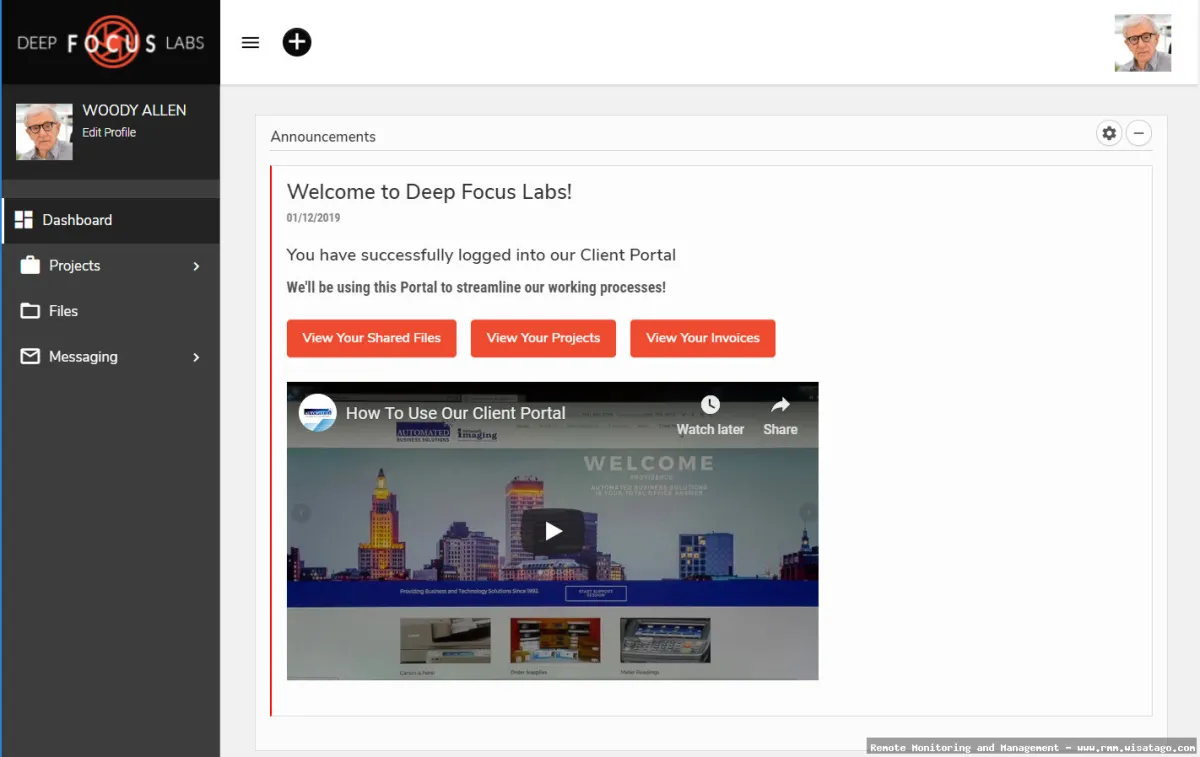In today’s fast-paced world of IT, managing client infrastructure efficiently and securely is paramount. As IT professionals, we’re constantly seeking ways to streamline operations, improve communication, and, most importantly, protect sensitive data. One of the most powerful tools at our disposal is the Remote Monitoring and Management (RMM) system, but its true potential is unlocked when seamlessly integrated with a secure client portal. This integration offers a unified platform for both IT providers and their clients, fostering transparency and trust while enhancing overall service delivery.
Think about the daily grind: juggling multiple support tickets, tracking asset information across various spreadsheets, and struggling to keep clients informed about the status of their IT environment. It’s a recipe for inefficiency and potential security vulnerabilities. A secure client portal integrated with your RMM system centralizes these processes, providing a single pane of glass for managing client interactions, monitoring system health, and resolving issues proactively. This not only saves time and resources but also strengthens client relationships by offering a more transparent and responsive service.

This article aims to provide a comprehensive guide to secure client portal integration with RMM systems. We’ll delve into the benefits, key features, implementation considerations, and potential challenges of this integration. Whether you’re already using an RMM system or exploring the possibility of adopting one, this guide will equip you with the knowledge to make informed decisions and optimize your IT service delivery.
Understanding the Synergy: RMM Systems and Client Portals
Remote Monitoring and Management (RMM) systems are the backbone of modern managed service providers (MSPs) and internal IT departments. They provide the tools necessary to remotely monitor, manage, and support IT infrastructure. This includes tasks like patch management, software deployment, antivirus updates, and performance monitoring. A client portal, on the other hand, is a secure web-based interface that allows clients to access information and interact with their IT provider.
The Core Functionality of RMM Systems
RMM systems offer a wide range of functionalities, including:
- Remote Monitoring: Continuously monitoring servers, workstations, and network devices for performance issues, security threats, and other critical events.
- Remote Access: Securely accessing client systems to troubleshoot problems, install software, and perform maintenance tasks.
- Patch Management: Automating the process of applying security patches and software updates to keep systems up-to-date and protected against vulnerabilities.
- Automation: Automating routine tasks such as script execution, software deployment, and system maintenance.
- Alerting and Reporting: Generating alerts when critical events occur and providing comprehensive reports on system performance, security posture, and other key metrics.
The Role of a Secure Client Portal
A secure client portal serves as a central hub for client communication and information access. Key features include:
- Ticket Management: Allowing clients to submit support tickets, track their progress, and communicate with IT support staff.
- Knowledge Base Access: Providing clients with access to self-service resources such as FAQs, troubleshooting guides, and documentation.
- Asset Management: Giving clients visibility into their IT assets, including hardware and software inventory, warranty information, and configuration details.
- Reporting and Analytics: Providing clients with access to reports on system performance, security posture, and service level agreements (SLAs).
- Secure Communication: Facilitating secure communication between clients and IT support staff through messaging and file sharing.
Benefits of Secure Client Portal Integration
Integrating a secure client portal with your RMM system unlocks a multitude of benefits for both IT providers and their clients.
Enhanced Communication and Transparency
A key benefit is improved communication. Instead of relying on email chains and phone calls, clients can easily submit tickets, track their progress, and communicate with IT staff through the portal. This transparency fosters trust and strengthens client relationships. Clients appreciate being kept informed about the status of their IT environment and the efforts being made to support them. For more information, you can refer to RMM as an additional resource.
Streamlined Support Processes
Integration streamlines support processes by centralizing ticket management, asset information, and communication within a single platform. IT staff can quickly access relevant information to resolve issues efficiently. The portal also allows for automated ticket routing and escalation, ensuring that issues are addressed promptly and by the appropriate personnel.

Improved Security Posture
A secure client portal enhances security by providing a controlled and authenticated access point to sensitive information. Multi-factor authentication (MFA) and role-based access control (RBAC) can be implemented to further strengthen security. By limiting access to authorized users and encrypting sensitive data, the portal helps protect against data breaches and unauthorized access.
Increased Efficiency and Productivity
Automation plays a crucial role in boosting efficiency. By automating routine tasks such as ticket creation, notification sending, and report generation, the integration frees up IT staff to focus on more strategic initiatives. This increased efficiency translates to higher productivity and improved service delivery.
Better Client Satisfaction
Ultimately, the benefits of integration lead to improved client satisfaction. Clients appreciate the transparency, responsiveness, and efficiency of the integrated platform. A well-designed and user-friendly portal can significantly enhance the client experience and foster long-term relationships.
Key Features to Look For in an Integrated Solution
When selecting an RMM system and client portal, it’s essential to consider the features that will best meet your specific needs. Here are some key features to look for:
Seamless Integration
The integration between the RMM system and client portal should be seamless and intuitive. Data should flow smoothly between the two platforms, and users should be able to easily navigate between them. Look for solutions that offer pre-built integrations or APIs that allow for custom integration.
Robust Security Features
Security should be a top priority. The client portal should offer robust security features such as:
- Multi-Factor Authentication (MFA): Requiring users to provide multiple forms of authentication to access the portal.
- Role-Based Access Control (RBAC): Limiting access to sensitive information based on user roles and permissions.
- Encryption: Encrypting sensitive data both in transit and at rest.
- Regular Security Audits: Conducting regular security audits to identify and address potential vulnerabilities.
Customization Options
The ability to customize the client portal is important for branding and tailoring the user experience. Look for solutions that allow you to customize the portal’s appearance, add your company logo, and configure the features that are available to clients.

Reporting and Analytics
The integrated solution should provide comprehensive reporting and analytics capabilities. You should be able to generate reports on system performance, security posture, service level agreements (SLAs), and other key metrics. These reports can be used to track progress, identify areas for improvement, and demonstrate value to clients.
Mobile Accessibility
In today’s mobile-first world, it’s essential that the client portal is accessible on mobile devices. Clients should be able to access the portal from their smartphones or tablets to submit tickets, track their progress, and communicate with IT staff.
Implementation Considerations and Best Practices
Implementing a secure client portal integration with your RMM system requires careful planning and execution. Here are some key considerations and best practices:
Planning and Preparation
Before implementing the integration, it’s important to define your goals and objectives. What do you hope to achieve with the integration? What features are most important to you and your clients? Once you have a clear understanding of your goals, you can develop a detailed implementation plan.
Data Migration and Synchronization
Migrating data from existing systems to the integrated platform can be a complex process. It’s important to carefully plan the data migration process to ensure that data is accurate and complete. You should also establish a process for synchronizing data between the RMM system and client portal to ensure that information is always up-to-date.
User Training and Documentation
Providing adequate training and documentation is essential for ensuring that both IT staff and clients can effectively use the integrated platform. IT staff should be trained on how to use the RMM system and client portal to manage client infrastructure and support requests. Clients should be provided with documentation and training on how to submit tickets, access self-service resources, and track the progress of their requests.
Security Hardening
After implementing the integration, it’s important to harden the security of the platform. This includes implementing strong passwords, enabling multi-factor authentication, and regularly patching vulnerabilities. You should also conduct regular security audits to identify and address potential weaknesses.

Ongoing Monitoring and Maintenance
The integration requires ongoing monitoring and maintenance to ensure that it continues to function properly and securely. You should regularly monitor system performance, security logs, and user activity. You should also apply security patches and software updates as they become available.
Potential Challenges and How to Overcome Them
While the benefits of secure client portal integration are significant, there are also potential challenges that you may encounter. Here are some common challenges and how to overcome them:
Integration Complexity
Integrating different systems can be complex and time-consuming. To overcome this challenge, choose solutions that offer pre-built integrations or APIs that allow for custom integration. You may also consider working with a qualified IT consultant to help with the integration process.
Data Security Concerns
Data security is a top concern when integrating different systems. To address this challenge, implement robust security measures such as multi-factor authentication, role-based access control, and encryption. You should also conduct regular security audits to identify and address potential vulnerabilities.
User Adoption
Getting users to adopt a new platform can be challenging. To overcome this challenge, provide adequate training and documentation. You should also clearly communicate the benefits of the integrated platform to users and solicit their feedback.
Cost Considerations
Implementing and maintaining an integrated solution can be expensive. To address this challenge, carefully evaluate the costs and benefits of different solutions. You may also consider phasing in the integration over time to spread out the costs.
The Future of RMM and Client Portal Integration
The future of RMM and client portal integration is bright. As technology continues to evolve, we can expect to see even more sophisticated and integrated solutions that offer enhanced functionality and improved security. Artificial intelligence (AI) and machine learning (ML) are likely to play a greater role in automating tasks, predicting issues, and providing personalized support. We can also expect to see increased emphasis on mobile accessibility and user experience.

In conclusion, secure client portal integration with RMM systems is a powerful tool for enhancing IT service delivery, improving communication, and strengthening client relationships. By carefully considering the benefits, key features, implementation considerations, and potential challenges, you can successfully implement an integrated solution that meets your specific needs and helps you achieve your business goals.
Conclusion
In conclusion, the integration of a secure client portal with your RMM system is no longer a luxury, but a critical necessity for modern MSPs. We’ve explored how this powerful combination streamlines communication, enhances security, and improves overall operational efficiency. By centralizing information access, automating tasks, and providing a branded, professional experience, MSPs can significantly boost client satisfaction and retention while simultaneously freeing up valuable technician time.
Ultimately, embracing this integration represents a strategic investment in your MSP‘s future. The benefits of improved security posture, enhanced client communication, and increased operational efficiency are undeniable. If you’re ready to elevate your service delivery and provide a superior client experience, we encourage you to explore the various secure client portal solutions available and discover how seamlessly they can integrate with your existing RMM system. Learn more about choosing the right portal and starting your integration journey by visiting our comprehensive guide here.
Frequently Asked Questions (FAQ) about Secure Client Portal Integration with RMM Systems
What are the key benefits of integrating a secure client portal with my Remote Monitoring and Management (RMM) system for my managed services business?
Integrating a secure client portal with your RMM system offers numerous advantages for managed services providers (MSPs). Firstly, it streamlines communication by providing a centralized platform for clients to submit support tickets, track their status, and access knowledge base articles. This reduces email clutter and phone calls, improving efficiency. Secondly, it enhances transparency by giving clients real-time visibility into their IT infrastructure’s health, performance metrics, and security alerts monitored by your RMM. This fosters trust and strengthens client relationships. Thirdly, a secure portal improves security by providing a controlled environment for sensitive data exchange and access, minimizing the risk of data breaches. Finally, it automates reporting, allowing clients to easily access customized reports on their IT environment, freeing up your team’s time. This integration ultimately leads to improved customer satisfaction, increased efficiency, and enhanced security.
How do I ensure the security of my client’s data when integrating a client portal with my RMM platform, and what security features should I prioritize?
Securing client data during client portal and RMM integration is paramount. Prioritize robust security features such as multi-factor authentication (MFA) to prevent unauthorized access. Implement strong encryption, both in transit (HTTPS) and at rest, to protect sensitive information. Regularly perform vulnerability assessments and penetration testing to identify and address potential weaknesses. Ensure compliance with relevant data privacy regulations, such as GDPR or HIPAA, depending on your clients’ industries. Role-based access control (RBAC) should be implemented to restrict user access based on their responsibilities. Furthermore, maintain detailed audit logs to track user activity and identify suspicious behavior. Look for RMM and portal solutions that offer security information and event management (SIEM) integration for real-time threat detection and response. It is also essential to keep the portal and RMM system software up-to-date with the latest security patches to mitigate known vulnerabilities. Finally, educate your clients and staff on security best practices to minimize the risk of human error.
What are the essential features to look for in a client portal that integrates well with my existing RMM system, and how do I assess the integration capabilities before implementation?
When choosing a client portal for RMM integration, several features are crucial. Seek a portal that offers seamless ticket management, allowing clients to submit, track, and manage support requests directly. Look for real-time asset visibility, displaying information gathered by your RMM about the client’s devices and infrastructure. Reporting capabilities are essential, enabling clients to access pre-built or custom reports on performance, security, and compliance. The portal should also facilitate secure document sharing, enabling the exchange of sensitive files in a controlled environment. Before implementation, carefully assess the integration capabilities. Verify that the portal supports API integration with your existing RMM system. Request a demo or trial period to test the integration firsthand. Inquire about the vendor’s integration support and documentation. Check if the portal can automatically synchronize data with your RMM, avoiding manual data entry. Finally, consider scalability; ensure the portal can handle your growing client base and data volume without performance degradation.